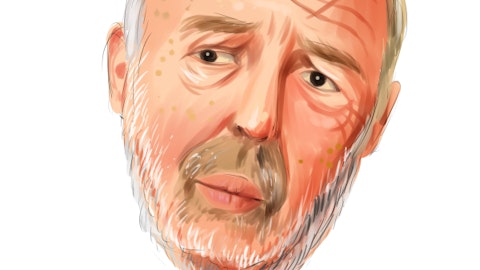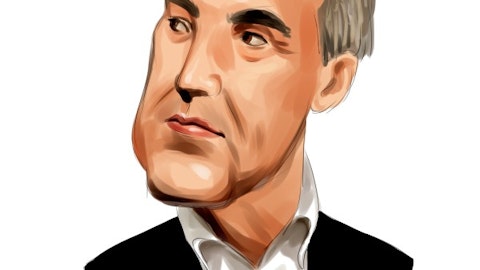California Resources Corporation (NYSE:CRC) Q4 2022 Earnings Call Transcript February 24, 2023
Operator: Good day, and welcome to the California Resources Corporation Fourth Quarter Earnings Conference Call. . And now I would like to turn the conference over to Joanna Park. Please, Joanna, go ahead.
Joanna Park: Welcome to California Resources Corporation’s Fourth Quarter 2022 Conference Call. Participating on today’s call are Mark McFarland, President and Chief Executive Officer; Francisco Leon, Executive Vice President and Chief Financial Officer; as well as the entire Executive Committee. I’d like to highlight that we have provided slides on our Investor Relations section of our website, www.crc.com. These slides provide additional information into our operations and fourth quarter results. We have also provided information reconciling non-GAAP financial measures discussed to the most directly comparable GAAP financial measures on our website as well as in our earnings release. Today, we are making some forward-looking statements based on current expectations.
Actual results could differ due to risk factors described in our earnings release and in our 10-K and other periodic SEC filings. As a reminder, we have allotted additional time for Q&A at the end of our prepared remarks. . With that, I will now turn the call over to Mac.
Mark McFarland: Well, great. Thank you, Joanna. Good morning, everyone, and thank you for joining us today. Over the past 2-plus years, following the company’s emergence from its financial restructuring, we have evolved CRC into an enterprise focused on generating the highest cash flow from our assets and returning that cash to shareholders. Case in point, in 2022, we returned 120% of free cash flow to shareholders through share repurchases and dividends. And we bought back 14% of the company’s outstanding shares since our emergence in late 2020. We also saw a tremendous opportunity for carbon management and have built a solid business around that. As any company — as any focused company should do, we continue to evolve. As we look forward to 2023 and beyond, we are announcing a strategic realignment of the company’s business operations and structure to adapt to current circumstances and build on our strong momentum.
As I have said before, and to say it simply, we are focused on generating the highest cash flow per share possible from our E&P business so we can return that cash to shareholders. Another case in point, if you take 2022 free cash flow of $311 million and the average fully diluted shares outstanding of 77.6 million during the year, we delivered $4 of free cash flow per share in 2022. And if you take the midpoint of our ’23 guidance, the $385 million of free cash flow and the fully diluted shares outstanding of 73.6 million at the end of January, we would expect to deliver $5.23 of free cash flow per share in 2023. That would be roughly a 30% increase in cash flow per share, and that is before we buy any more shares back in 2023, which would drive the results even higher.
That is the benefit of our low decline assets and the toggles we have available to us in the business. In connection with the strategic alignment, we are announcing management and Board changes to support the eventual separation of our E&P and carbon management businesses. We are also cutting costs to match activity levels, and we plan to increase our financial flexibility to accelerate shareholder returns. By taking these steps, we believe we can create a different kind of energy company and drive cash flow per share growth. With the revised corporate structure, Francisco Leon, will succeed me as CEO, and I will step back from the day-to-day management role. I will continue to serve on the Board of CRC and will chair the newly formed Board of our Carbon TerraVault subsidiary, which will be devoted to overseeing the continued growth of the carbon management business.

Photo by Max Bender on Unsplash
Two existing CRC nonexecutive Directors, Andrew Bremner and James Chapman, will also serve on the subsidiary board. Together, we will provide the business with insight into the commercialization of new technologies, provide expertise in corporate and financial structuring as well as provide knowledge relevant to early movers for carbon capture and storage in California. I’ve had the tremendous opportunity to work with the great people of CRC and forged many great friendships. And having spent more than 2 years working with Francisco side-by-side, I am confident he is the right person to lead us at this exciting time and going forward. I’ll now turn it over to Francisco to share more details on the steps we’re taking to position our business for success.
Francisco?
Francisco Leon: Thanks, Mac, and thank you, everyone, for joining the call. I will focus my comments on the actions we are taking to enhance value and deliver stronger shareholder returns and to maximize cash flow per share of the business. But first, we have provided detailed analysis about our 2022 quarterly and yearly financial and operational results and also our 2023 guidance in the attachments to our earnings release and in our slide deck. I will refer you to those documents for that information rather than cover them on this call. But as you will see, 2022 year-end financial results were very strong, with over $300 million of free cash flow, helping showcase our resilient and valuable portfolio of assets. As we delivered on all of our 2022 priorities, and look at what’s in front of us in the next chapter, we must continue to evolve.
So here’s our plan for 2023. We are going to focus our development and drilling plan on developing the highest returning projects with permits in hand. That, combined with well servicing and downhole maintenance, will help reduce our base production declines. We will do this by reducing capital investment to 1.5 rigs, which is based on permits in hand in the Wilmington field for high rate-of-return projects with short paybacks. This constitutes a run rate E&P CapEx program of $155 million per annum as demonstrated with our 2023 program, and as you can see on Slide 10 of our presentation. We’re also adding OpEx dollars to downhole maintenance, increasing our rig maintenance count by 6 to 38, which, combined with our capital program, we expect to deliver a 5% to 7% total decline for the company.
We have a backlog of about 1,000 wells that we can go after and return to service and return to engineering that allow us to make high-impact investments with very little incremental operating expenditure dollars. Given reduced activity levels across our E&P business, we’re also looking to reduce all other nonenergy operating costs and adjusted E&P corporate and other G&A costs by 5% to 10% by year-end, aligning our cost to activity level. We have successfully implemented similar strategies in the past, and believe the company is well positioned to identify and achieve additional cost reductions while maintaining the high operational and safety standards that CRC has achieved over the years. In addition to the revisions to our operating plan, we’re also pursuing ways to increase our financial flexibility to bolster the company’s ongoing shareholder return program and enable a potential future separation of the company.
To help achieve this financial flexibility, we intend to refinance the $600 million high-yield notes and extend or replace our RBL. Clearly, having Carbon TerraVault operate on a stand-alone basis will broaden capital sourcing option for that business. Our continued focus on costs, and our ability to maintain production due to the high quality of our assets, gives us confidence in our cash flow projections. And as such, CRC’s Board has authorized a 30% increase to the share repurchase program for a total of $1.1 billion, with $640 million remaining of dry powder. With this plan in 2023, we expect to generate $455 million of E&P free cash flow and total corporate after-tax free cash flow of $385 million. Of this, we intend to return 100% to shareholders in 2023, continuing our track record of returning more than 100% of cash to shareholders and maximizing cash flow per share.
If market conditions persist in 2024 and beyond, we will repeat this plan. If we assume a 1.5 rig count going forward, we are confident that we can lower our capital plan of approximately $155 million of drilling and completion capital. We can make the appropriate reductions to our cost structure that we expect will ensure that we deliver improving operating and financial metrics on a per share basis. I am really excited about the future of CRC and look forward to working with our talented team to take the steps to separate our quality, low decline, low carbon intensity and high cash flow generating E&P business in our California leading Carbon TerraVault, which we will unlock — which will help unlock the company’s full potential for delivering value to shareholders.
I want to take a moment to thank Mac for his leadership these last 2 years and look forward to working with him to accelerate the growth of our carbon management business. Thank you for your interest in CRC, and thank you for joining us on the call today. We’ll now open the line for questions. Operator?
See also Top Investors’ Stocks Portfolio: Mid-Cap Stocks and 12 High Growth Software Stocks that are Profitable.
Q&A Session
Follow Chromcraft Revington Inc (NYSE:CRC)
Follow Chromcraft Revington Inc (NYSE:CRC)
Receive real-time insider trading and news alerts
Operator: . Our first question comes from Scott Hanold from RBC Capital.
Scott Hanold: Francisco, congrats on the promotion, well-deserved, and Mac, congrats on all your leadership to this point and in the future. So good to see those moves in place. But my first question is going to be around permitting. And maybe a little bit of a multifaceted question, but let me give it a shot here. Can you give us a sense — the decision to go to this 1.5 rig count and lower activity pace, has your view changed on the litigation that’s ongoing in Kern County? Has that changed that drove that opinion? And then could you also give us a sense of like how many total permits do you have in hand? And in what basins? And just to give us a sense of like how much runway you have outside of 2023?
Francisco Leon: Scott, thanks for your nice words and the question. So when we issued the 8-K a few weeks ago around the appeal process in Kern County. And I think what we were looking to do today after getting feedback from all of our investors was to showcase what the plan would be on a go-forward basis, and that’s what we did today. So the 1.5 rigs is — has effectively all concentrated in the Wilmington field. As you know, we operate in 3 fields — 3 basins, the Sacramento Basin, Kern County, San Joaquin Basin and then the L.A. Basin. So the litigation is only around Kern County, so that gives us optionality to go to these other 2 basins. So we’re focusing activity in the LA basin in the Wilmington field. And we have a lot of runway there.
It’s kind of independent process to get permits. Nothing has really changed around the appeal process. We — what we said is, okay, obviously, if we can get some good news there, and we’re also working on alternative plans around individual field , right? So remember, this is a Kern County-wide permitting process, but we can still go to individual fields to get those full permits replaced. So we’re working through that, nothing’s really changed, but what we wanted to provide was a view to our shareholders that what we would do in case the appeal process continues and drags on. So to us, there’s upside to the story. We’ve already communicated when we saw the impact, and we think we can deliver 1.5 rigs on a go-forward basis if the appeal process continues to drag on.
Scott Hanold: Okay. I appreciate all that color. And as my follow-up question, I mean, there’s a lot of different questions I could ask here, but obviously, you have to talk about the strategic kind of repositioning of the company. And could you give us your view of the vision for what you think is going to transpire? And how you get there on the time line? So it sounds like you’re separating the 2 businesses. Do you have separate management teams? And is the path to separation first to get the EPA Classics permit in hand and then go down that path? Or is it a little bit more of a longer or shorter process?





